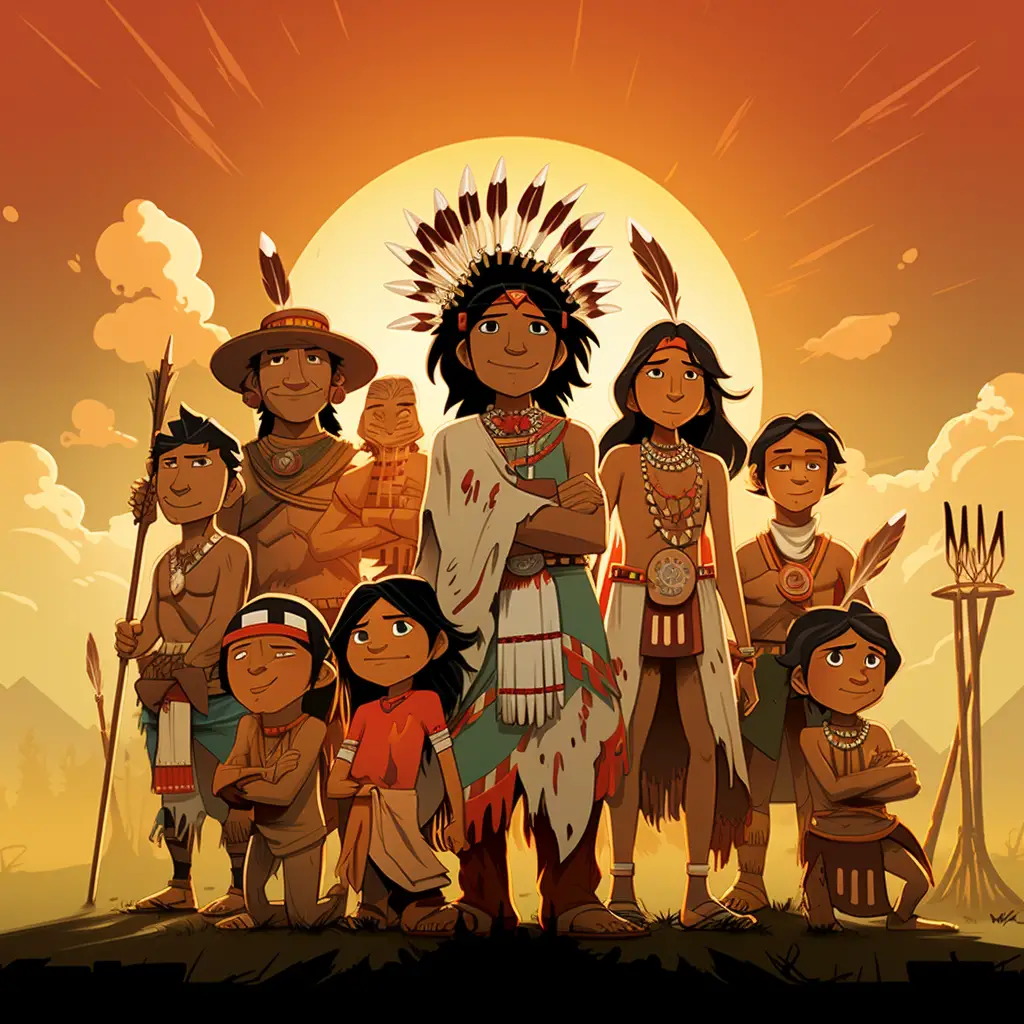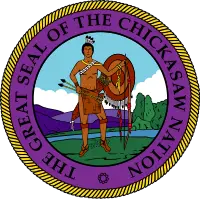Chickasaw Tribe
The Chickasaw are a relatively small native tribe. They are located in the Southeast United States, and were one of the Five Civilized Tribes. Before they were forced away from their homes during the 1830s, most Chickasaw lived in Mississippi.
The Chickasaw people are a Native American tribe that originated in the Southeastern United States. They have a rich history and culture, with their own language, traditions, and customs. The Chickasaw Nation is recognized as a sovereign nation and has its own government, laws, and institutions. Today, the Chickasaw people continue to thrive and preserve their heritage through various initiatives and programs.

Chickasaw Tribe Facts For Kids
- The Chickasaw Tribe is native to the southeastern US.
- They were known as the “Unconquerable People”.The
- The Chickasaw language is part of the Muskogean family.
- Corn, beans, and squash were the main Chickasaw crops.
- They lived in houses called ‘Chickees’ made of reeds.
- Chickasaw were expert traders and warriors.
- The tribe’s social structure was matrilineal.
- They played stickball, a game similar to lacrosse.
- Chickasaw allied with the British in colonial times.
- They were relocated to Oklahoma in the 1830s.
Native Americans history
The ‘Unconquered and Unconquerable’ Chickasaw Tribe holds a noteworthy position within Native American history. This tribe, originating from the Southeastern United States, belongs to the ‘Five Civilized Tribes’, a group that also encompasses the Cherokee, Choctaw, Creek, and Seminole tribes.
Known for their superior combat abilities and fierce resistance against European invaders, the Chickasaws were also recognized for their advanced agricultural practices, significantly influencing the development of trade routes in the Mississippi region.
The 1830s saw the tribe’s enforced relocation to Indian Territory, now Oklahoma, under the Indian Removal Act – a harsh journey known as the Trail of Tears that underscored their resilience. Today, the Chickasaw Nation continues to honor their rich cultural heritage while contributing to diverse societal sectors such as education, health, and commerce.
Southeastern tribes
The Chickasaw Tribe, originally hailing from Southeastern regions of the United States such as Mississippi, Alabama, and Tennessee, is recognized for its rich cultural legacy and significant contributions to American history.
Renowned for their highly advanced matrilineal ruling system and formidable warrior culture, they also excelled in farming, cultivating crops like corn, beans, and squash, much like their Southeastern tribal counterparts. Despite the tribulations faced during the Trail of Tears in the 1830s when they were forcibly relocated to Oklahoma, the tribe has successfully preserved its cultural heritage and traditions.
Today, they continue to demonstrate remarkable resilience, strength, and an unwavering commitment to their ancestral values, playing a significant role in the Southeastern tribal community.
Trail of Tears
Originating from the southeastern United States, the Chickasaw Tribe faced a significant ordeal during the Trail of Tears in the 1830s. The Indian Removal Act, endorsed by President Andrew Jackson, led to the forceful eviction of the Chickasaws from their ancestral territory, pushing them west into present-day Oklahoma.
The tribe’s endurance was put to the test throughout this arduous 500-mile journey, during which they grappled with severe weather, rampant disease, and acute starvation. Even though the Chickasaw Tribe sought to negotiate fair compensation for their lands with the U.S. government, they were given less than half of the stipulated amount.
A large number of tribe members lost their lives in this distressing event, commonly known as the Chickasaw Trail of Tears, marking a bleak period in the tribe’s history.
Mississippi culture
The Chickasaw tribe, originally from the southeastern U.S., has profoundly influenced Mississippi’s culture in a multitude of ways that still resonate today.
As one of the ‘Five Civilized Tribes’, they were recognized for their advanced farming practices, complex political systems, and expansive trade networks. These aspects significantly molded the cultural panorama of Mississippi. This tribe’s language, traditions, and artistic contributions, including pottery, basket weaving, and intricate beadwork, continue to inspire the state’s local arts and crafts.
Mississippi’s literary culture has been enriched by the Chickasaw’s storytelling tradition, abundant in folklore and legends passed down through generations. Notably, their reputation as fierce warriors with strategic skills is reflected in Mississippi’s historical and heritage narratives. Today, the Chickasaw tribe’s legacy endures, playing a vital role in shaping Mississippi’s multicultural identity.
Five Civilized Tribes

The Chickasaw Tribe, a constituent of the Five Civilized Tribes also including the Choctaw, Cherokee, Creek, and Seminole, was originally based in the southeastern United States. European settlers dubbed them ‘civilized’ due to their assimilation of various European customs such as democratic governance, Christianity, literacy, and other cultural norms.
However, in the 1830s, the Chickasaw and their affiliated tribes experienced a forced displacement from their ancestral lands via the Indian Removal Act—an event tragically known as the Trail of Tears.
Despite this, the Chickasaw tribe resiliently reestablished their society in Oklahoma, where they continue to flourish and preserve their rich cultural heritage today.
Choctaw, Creek, and Seminole tribes
The Chickasaw Tribe, colloquially known as the ‘Spartans of the Lower Mississippi Valley,’ shares extensive historical and cultural ties with the Choctaw, Creek, and Seminole tribes, despite their unique histories.
As part of the Five Civilized Tribes, they all originate from the southeastern United States and share many commonalities. For instance, the Chickasaw and Choctaw tribes are linked through a shared ancestry and the Muskogean language group.
The 1830s saw the forced relocation of the Chickasaws, similar to the Creek and Seminole tribes, during the tragic Trail of Tears. However, the Chickasaws, like their Choctaw, Creek, and Seminole counterparts, managed to preserve their tribal identity and cultural traditions amid these adversities.
Indian Removal Act
Under President Andrew Jackson’s administration in 1830, the Indian Removal Act had a significant impact on the Chickasaw Tribe, one of the ‘Five Civilized Tribes’ that included the Cherokee, Choctaw, Creek, and Seminole.
The Act forced the Chickasaw, who were originally based in the Southeastern United States, encompassing regions like Mississippi, Alabama, and Tennessee, to relocate to what is now known as Oklahoma. Despite the forced displacement, the Chickasaw managed to negotiate the sale of their lands successfully, which provided them with the financial resources needed for their new life in unfamiliar territory.
However, the move, infamously known as the ‘Trail of Tears,’ was marred by severe weather, disease, and starvation, leading to immense hardship and loss. Despite the adversity, the Chickasaw people’s resilience and adaptability shone through as they managed to establish new communities in Oklahoma and preserve their valued cultural traditions.
Chickasaw language
The Chickasaw language, an integral part of the Muskogean language family and the Chickasaw tribe’s rich cultural heritage, is distinctive and intricate, bearing a structure that significantly differs from English while closely mirroring Choctaw, another Muskogean language.
Historically primarily oral language, stories, histories, and knowledge were passed down verbally through generations. In a bid to revitalize their language, the tribe has initiated substantial efforts including offering language classes, developing mobile apps, and translating books into Chickasaw.
However, with only a few dozen fluent speakers remaining, mostly elderly, the issue of language preservation has become increasingly critical for the Chickasaw tribe.
Chickasaw Nation today
The Chickasaw Nation, a federally recognized Native American tribe, is currently headquartered in Ada, Oklahoma. Known historically as the ‘Spartans of the Lower Mississippi Valley,’ the tribe was among the ‘Five Civilized Tribes’ forced to relocate during the harrowing ‘Trail of Tears.’
Despite this tumultuous past, the Chickasaw people have demonstrated resilience, fostering a vibrant culture and achieving economic stability. Their diverse economic interests encompass successful ventures in tourism, gaming, and agriculture, contributing to their prosperity.
The Nation operates two top-tier medical centers and its own education system, in addition to various cultural and recreational programs aimed at preserving its rich heritage. The Chickasaw also celebrate their culture and history annually through the Chickasaw Festival, featuring traditional music, art, dance, and other cultural activities.
Chickasaw-Choctaw wars.
In the 18th century, the traditional territories and historical trajectories of the Chickasaw and Choctaw tribes were significantly influenced by their series of wars, known as the Chickasaw-Choctaw wars.
These conflicts stemmed from the Chickasaw tribe’s territorial disputes with its neighbors, including the Choctaws. Despite being numerically inferior, the Chickasaws, who were known for their formidable war tactics and fierce warrior reputation, often gained the upper hand due to strategic alliances formed with European colonizers such as the English and later the Americans.
These alliances not only allowed them to maintain their autonomy but also intensified the brutality and violence of the wars, thereby leaving a lasting impact on both tribes.

The Brave Chickasaw Warriors: Defenders of Their Land
The Chickasaw were regarded as fierce warriors. This is probably because they were a small society, and were surrounded by Europeans or other tribes who might pose a threat to them. Many people regarded the Chickasaw as the bravest of the Southeastern Indians. Training for Chickasaw warriors began in childhood. Boys were taught to fight and also to withstand pain without complaining. War chiefs were very respected and had great authority in Chickasaw villages. They also built fortified towns to withstand attacks. The Chickasaw never lost a major battle or war. The word Chickasaw translates to “rebel.” I think the name fits!
For many years, the Chickasaw fought the French in Mississippi. The French were angry that the Chickasaw traded for weapons with the English in the Carolinas. The Chickasaw fought the French in two wars in the 1720s and 1730s. After France was defeated in the French and Indian War, they no longer posed a serious problem for the Chickasaw. Relations with the nearby Choctaw Indians also improved in the 1700s.
Chickasaw Warriors: Defenders in the American Revolution
When the American Revolution began, the Chickasaw felt that they should support the English. Their good relations with the English had kept them safe for many years. The colony of Virginia wrote the Chickasaw nation and threatened to attack if they supported England. The bold Chickasaw responded by telling them not to bother invading their lands—the Chickasaw would meet them halfway and send them back without their heads! When the Revolution ended, the Chickasaw established relations with the new United States.
Chickasaw Resilience: Facing Change and Celebrating Artistry
The Chickasaw endured the same hardships as many other native societies when white settlers began moving into their lands. Many white settlers moved into Mississippi in the 1820s. During the 1830s, the Chickasaw were forced out of the Southeast along with the rest of the Five Civilized Tribes.
Although the Chickasaw were known for their skill in battle, they also had other many other skills. They were known (and still appreciated) for their beautiful baskets. These were often brightly colored with natural dyes, such as sassafras root.
Chickasaw Homes and Playgrounds: Where Seasons and Fun Meet
The Chickasaw were semi-nomadic. This means that they generally stayed in one spot, but might migrate according to the seasons. The Chickasaw built both winter and summer houses. The winter house was the larger of the two. The summer house had two rooms and plenty of ventilation to keep the occupants cool. The Chickasaw also liked to play. In addition to their homes, they usually built a ball field!
Things to remember about the Chickasaw:
- Chickasaw society was matrilineal, which means ancestry was passed through the mother’s side. Women also controlled their own land.
- Most present-day Chickasaw speak English, but there are a very small number who still speak Chickasaw. It’s important to the Chickasaw that their language be preserved.



